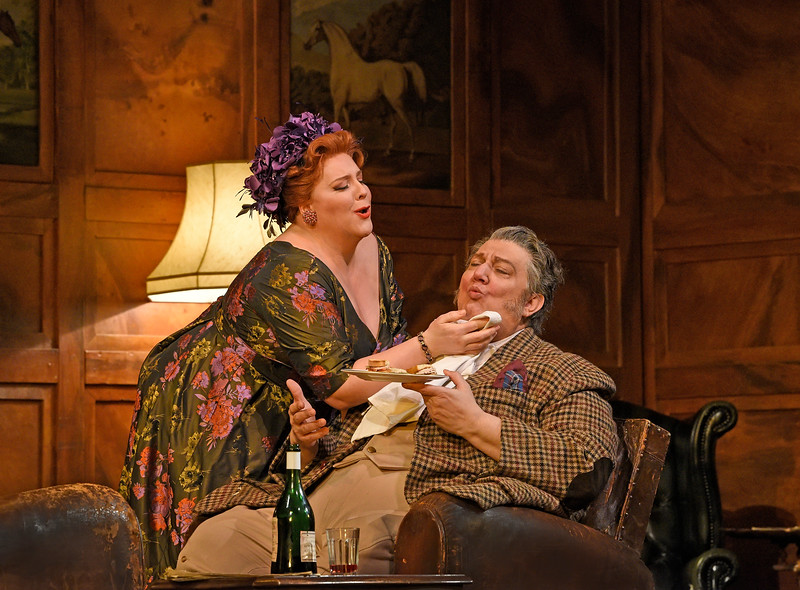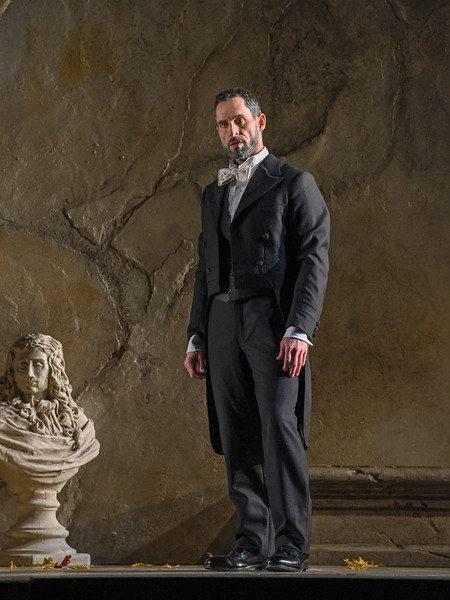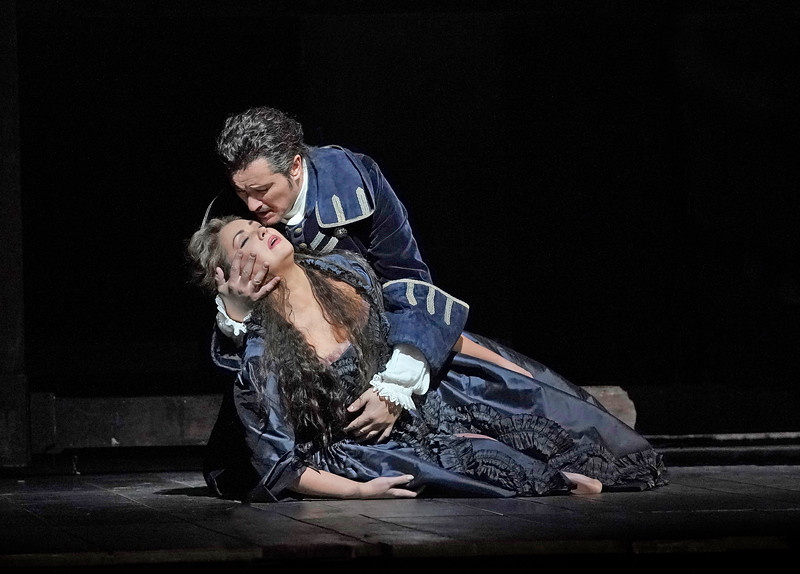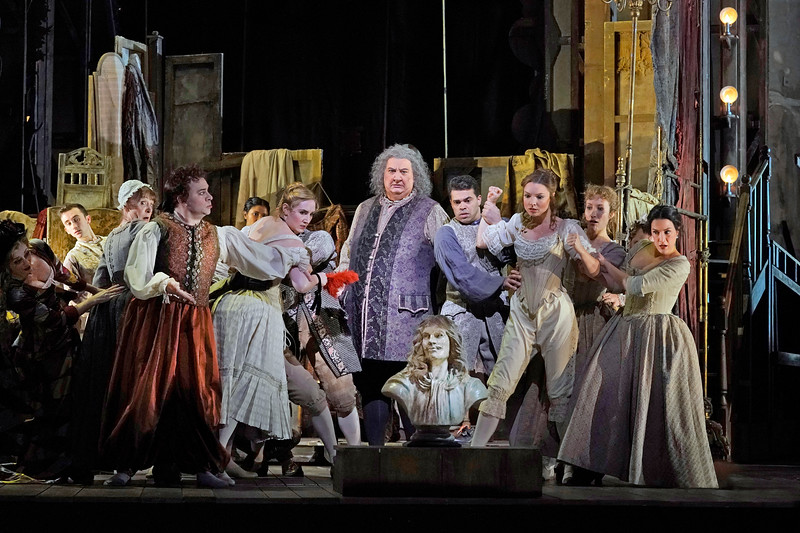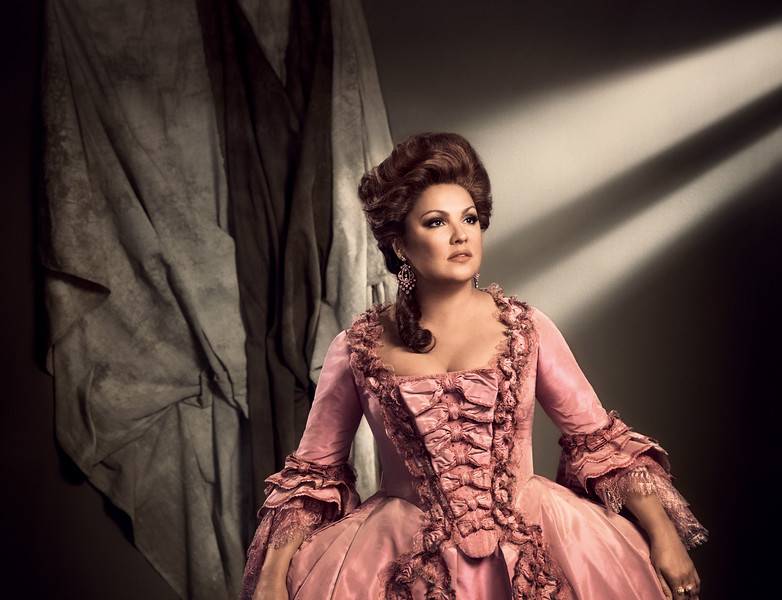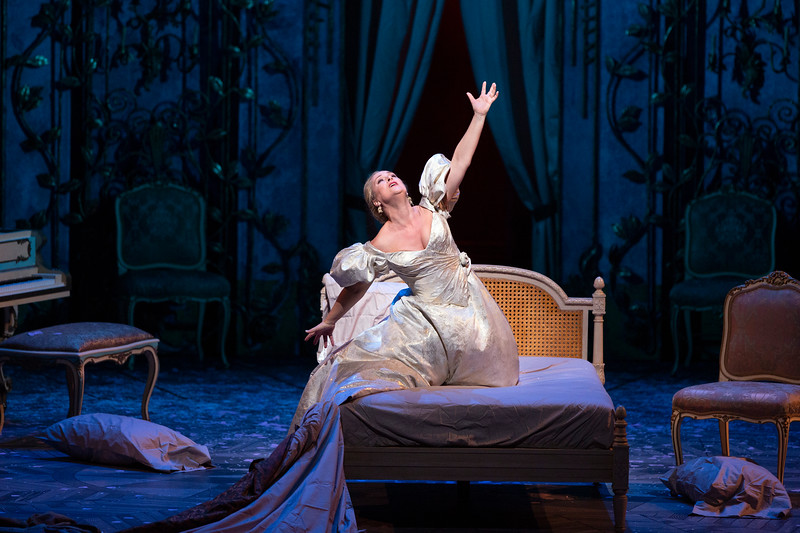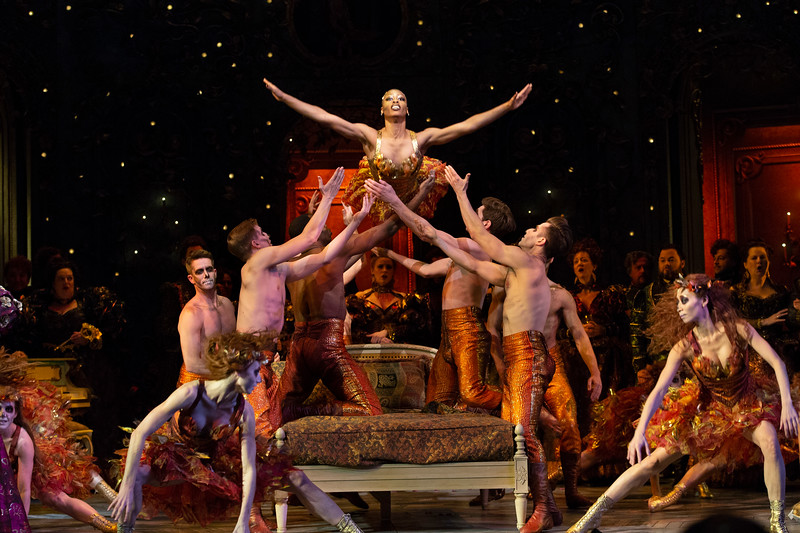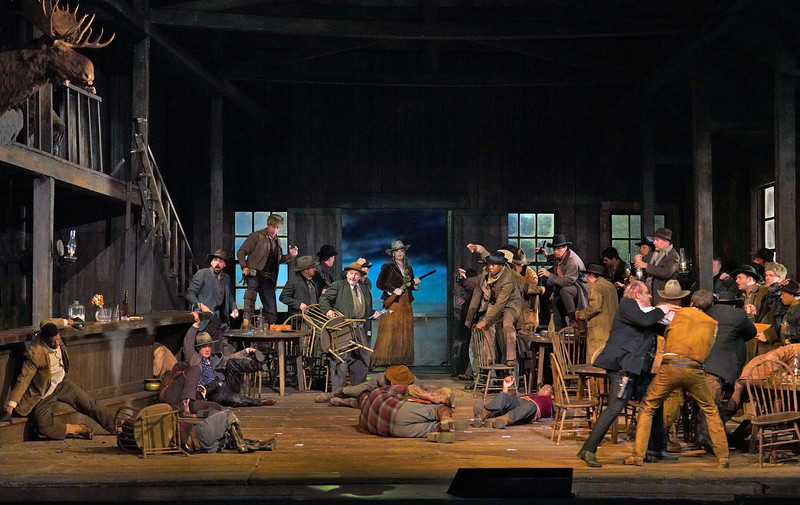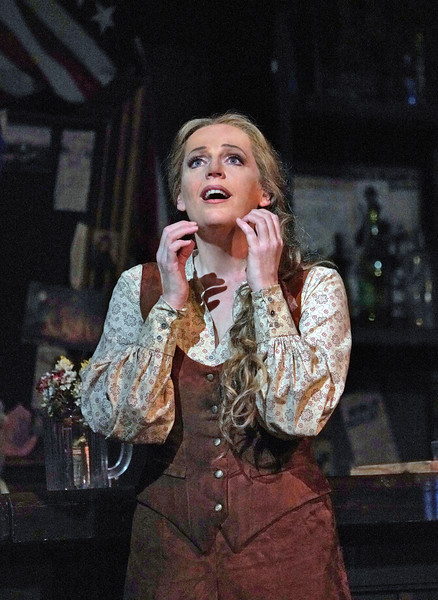A joyful Falstaff sparkles at the Met
Verdi’s Falstaff is a comic masterpiece in the broader sense of the word ‘comedy.’ Like Cervantes’ Don Quixote or Ariosto’s Orlando, Shakespeare’s Falstaff is a larger than life character who is, to some extent, delusional about his current worth in the real world. However, Arrigo Boito, the librettist for Verdi’s Falstaff, gives the fallen knight a moment of clarity at the opera’s conclusion: Son io che vi fa scaltri, l’arguzia mia crea l’arguzia degli altri, variously translated as “It is I who season [the otherwise flat and flavorless arrogance of you all]. My cleverness creates the cleverness of others,” which ultimately leads to his parting assessment of the human condition: Tutto nel mondo è burla, “All the world’s a jest.”
Just about sums things up these days.
Falstaff courts Alice Ford in her modern kitchen in Scene IV of Act I
Robert Carsen’s production, new in 2013, updates the setting to post-WWII Windsor, a time when the British aristocracy was more evidently on the slide than in the prewar Downton Abbey days. Sir John is scrounging for money to supply food and drink for himself and for his hangers-on of dubious reputation. His scheme to get his former greatness back shapes the action of the evening. Carsen realizes this story well; as in his recent Der Rosenkavalier, Carsen creates humorous actions as asides to the main action, such as, here, the men in the gentlemen’s lounge quietly reading their newspapers until a flamboyant Mistress Quickly barges in to tempt Falstaff with Alice Ford’s trap or the frequent pick-pocketing by Bardolfo, one of the aforementioned dubious hangers-on. And you won’t forget the horse.
Mistress Quickly finds compelling methods to soften any of Falstaff’s resistance
And under his direction, realized in this revival by Gina Lapinski, the characters have signature movements, mostly merry and bouncy, again to make it a never-a-dull-moment kind of evening. As such, they’re completely consistent with Verdi’s incredible score. Richard Farnes, making his Met debut with Falstaff, allows the orchestral riches to bubble to the surface without overwhelming the singers. Welcome to the Met!
Ambrogio Maestri recaps his portrayal of the grand Falstaff. Maestri is a man of commanding stature with a sizeable voice, a man who seems to live well within the large ego of his stage character. One is struck by his audacity as much as by his flights of grandeur. Yet there is an echo of nobility in his bearing.
Bardolfo and Pistola, sung by Keith Jameson and Richard Bernstein respectively, are smaller, more shifty sorts, the former, especially, like a mouse who comes out at night for a nip of cheese. Or a wallet or purse. Keep your eye on him.
Alice Ford, Mistress Quickly, Meg Page, and Nannetta compare letters from Falstaff
Of the merry wives, Ailyn Pérez is simply charming as Alice Ford, as a character and as an artist. To Jennifer Johnson Cano and Marie-Nicole Lemieux go much praise for creating over-the-top funny but plausible women, co-conspirators in the plan to shame Sir John. As said above, there is much humor in the little things going on in the background. Watch Cano, as Meg Page, standing on the kitchen countertop waving her arms in the final scene of the first Act; Lemieux’s Mistress Quickly comically aims her assault on Falstaff directly at his weak points. The merry wives are in perpetual motion and wonderfully choreographed.
Of the lovers, Golda Schultz as Nannetta has a heavenly voice and the agility of a young woman in love: Nannetta must slide in and out of hanging with the olds or furthering her suit with young Fenton. Francesco Demuro as Fenton is a worthy suitor. Again, both in perpetual motion and wonderfully choreographed.
Ford, disguised as Fontana, approaches Falstaff with a deal
Juan Jesús Rodríquez is a strong voice for a strong Ford. At first meeting, he appears to be from Texas, probably made his wealth in oil or cattle, married British class. Or it could be Fontana’s disguise. Dr. Caius is sung by Tony Stevenson.
Again like Robert Carsen’s Der Rosenkavalier, his Falstaff is often played out in relatively large spaces, at least the width of the Met’s stage, if not always the depth. The space is filled with relevant things, like the waiter’s serving carts stored in Falstaff’s bedroom. Or are the carts just left there from Falstaff’s frequent room service requests? At least Paul Steinberg’s sets allow voices to project out rather than get lost and they also can be changed in a relatively brief pause, as indicated in the subtitles, rather than a not-so-brief pause. The details of the sets in Act I (as performed) well define the era. If you grew up around then you’ll recognize the kitchen immediately. The sets for Act II (as performed) is relatively timeless. Brigitte Reiffenstuel’s costumes fit as well. Robert Carsen and Peter Van Praet designed the lighting.
The magical midnight in Windsor Park. The Queen of the Fairies appears to Falstaff
Falstaff, coming after Otello, is the last opera Verdi wrote. He was seventy-nine at the opera’s premiere at La Scala in 1893. Incredible.
Performance date: March 2, 2019, the 188th performance.
Photos: Karen Almond
Verdi’s Falstaff, as written, is in three acts, but performed in two, one large and one smaller: Acts I and II are combined, then a lights-up intermission, Act III follows by itself. Between the four scenes comprising Acts I and II are “brief pauses.” The running time of the complete performance is about two hours and 40 minutes.
Enjoy! Falstaff is high on my list of all-time favorite operas, easily in the top 25. It’s wise, artful, touching, ultimately a wonderfully happy opera! My first at the Met was in early April in 1964, a Friday as I recall. It was the new Franco Zeffirelli production with Leonard Bernstein at the helm and the first cast (Gabriella Tucci, Judith Raskin, Rosalind Elias, Regina Resnick, Mario Sereni, and Luigi Alva, though the great Fernando Corena was Falstaff. The next night was my first Otello with James McCracken, Renata Tebaldi, and Anselmo Colzani…big weekend indeed!! The Falstaff (and the Otello) was first of many many memorable nights at the Met. Big regrets that I missed Tito Gobbi in the title role, but a cat can’t do it all. I cherish his recording with von Karajan, et al. on EMI. The clicks and scratches on the old Angel LPs still linger in my mind’s ear, happily nonexistent on the CD release. Check it out.
Happy trails. OM

